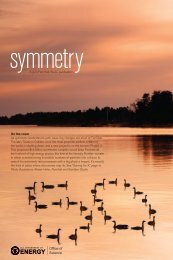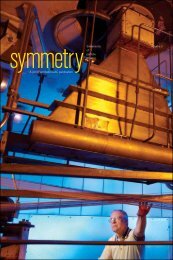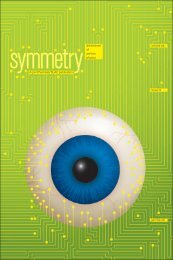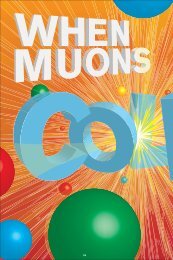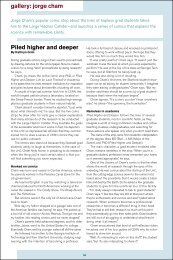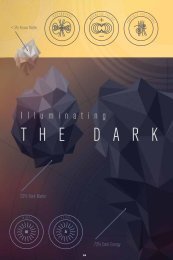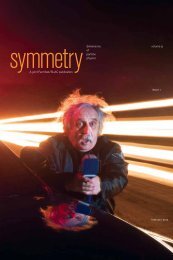when bad physics pop up in a movie or tv show, scientists try to set ...
when bad physics pop up in a movie or tv show, scientists try to set ...
when bad physics pop up in a movie or tv show, scientists try to set ...
Create successful ePaper yourself
Turn your PDF publications into a flip-book with our unique Google optimized e-Paper software.
The<br />
w r o n g<br />
stuff<br />
When <strong>bad</strong> <strong>physics</strong> <strong>pop</strong><br />
<strong>up</strong> <strong>in</strong> a <strong>movie</strong> <strong>or</strong> TV<br />
<strong>show</strong>, <strong>scientists</strong> <strong>try</strong><br />
<strong>to</strong> <strong>set</strong> th<strong>in</strong>gs right.<br />
By Amelia Williamson<br />
Pho<strong>to</strong>-illustrations: Reidar Hahn and Fred Ullrich, Fermilab<br />
24
25<br />
symme<strong>try</strong> | volume 04 | issue 08/09 | oct/nov 07
Physicist Brian Cox has been watch<strong>in</strong>g<br />
science fiction <strong>movie</strong>s s<strong>in</strong>ce he was<br />
a small child. He always scoffed at the<br />
imprecise nature of the science <strong>in</strong><br />
<strong>movie</strong>s. But over the past year, he learned a lot<br />
about the balance between mak<strong>in</strong>g a <strong>movie</strong><br />
enterta<strong>in</strong><strong>in</strong>g and mak<strong>in</strong>g it scientifically c<strong>or</strong>rect.<br />
Cox w<strong>or</strong>ked closely with Danny Boyle, direct<strong>or</strong><br />
of the <strong>movie</strong> Sunsh<strong>in</strong>e, <strong>to</strong> ensure that the science<br />
<strong>in</strong> the <strong>movie</strong> was as respectable as possible.<br />
“I was pretty pedantic about science fiction bef<strong>or</strong>e<br />
I w<strong>or</strong>ked on Sunsh<strong>in</strong>e,” Cox says. “I learned about<br />
the compromises that have <strong>to</strong> be made <strong>in</strong> <strong>or</strong>der<br />
<strong>to</strong> make a <strong>movie</strong> an emotional journey, rather than<br />
just a documentary.”<br />
Sunsh<strong>in</strong>e is <strong>set</strong> 50 years <strong>in</strong> the future. The sun<br />
is dy<strong>in</strong>g and is no longer provid<strong>in</strong>g the energy<br />
that humans need <strong>to</strong> survive. The global community<br />
pulls <strong>to</strong>gether <strong>to</strong> send a team of eight <strong>scientists</strong><br />
on a mission <strong>to</strong> reignite the dy<strong>in</strong>g sun with a bomb<br />
the size of Manhattan. The first gro<strong>up</strong> of <strong>scientists</strong><br />
sent on the mission had failed, and this<br />
second team is Earth’s only hope. On their way<br />
<strong>to</strong> the sun, the <strong>scientists</strong> f<strong>in</strong>d the wrecked ship<br />
from the previous mission and decide <strong>to</strong> pick <strong>up</strong><br />
its bomb <strong>to</strong> double their chances of succeed<strong>in</strong>g.<br />
The premise of the film seems preposterous.<br />
While the sun, like other stars, will eventually burn<br />
out, <strong>scientists</strong> calculate that this will take about<br />
four <strong>to</strong> five billion years. If it did burn out, how<br />
could a bomb—even one the size of Manhattan—<br />
reignite it?<br />
The<strong>or</strong>etically, all this could happen, Cox says<br />
<strong>in</strong> a Q&A posted on the <strong>movie</strong>’s Web site. He<br />
helped come <strong>up</strong> with a back st<strong>or</strong>y, not expla<strong>in</strong>ed<br />
<strong>in</strong> the <strong>movie</strong>, <strong>in</strong> which a hypothetical type of<br />
a<strong>to</strong>mic nucleus called a Q ball hits the sun and<br />
rips its a<strong>to</strong>ms apart, turn<strong>in</strong>g them <strong>in</strong><strong>to</strong> particles<br />
called squarks.<br />
As f<strong>or</strong> the bomb, it would use uranium <strong>to</strong><br />
trigger dark matter, which is thought <strong>to</strong> make <strong>up</strong><br />
a large fraction of the universe. This would<br />
create enough heat <strong>to</strong> split the Q balls apart.<br />
This scenario assumes that a number of<br />
unverified the<strong>or</strong>ies are, <strong>in</strong> fact, c<strong>or</strong>rect, Cox says.<br />
Even if the the<strong>or</strong>ies were c<strong>or</strong>rect, Q balls might<br />
pass through the sun without s<strong>to</strong>pp<strong>in</strong>g, <strong>or</strong> destroy<br />
it at a much slower rate than <strong>show</strong>n <strong>in</strong> the <strong>movie</strong>.<br />
With<strong>in</strong> the <strong>movie</strong>’s science-fiction framew<strong>or</strong>k,<br />
the direct<strong>or</strong> wanted the <strong>scientists</strong> <strong>to</strong> be as<br />
authentic as possible. He contacted Cox after<br />
see<strong>in</strong>g the young Manchester University physicist<br />
on one of the BBC’s H<strong>or</strong>izon <strong>show</strong>s, and<br />
asked him <strong>to</strong> teach the act<strong>or</strong>s how <strong>to</strong> act like<br />
physicists. Cox w<strong>or</strong>ks at CERN, the European<br />
particle <strong>physics</strong> lab <strong>in</strong> Switzerland.<br />
Tweak<strong>in</strong>g the science<br />
Cox is one of a number of scientist consultants<br />
who w<strong>or</strong>k <strong>to</strong> make <strong>movie</strong>s and TV <strong>show</strong>s as<br />
scientifically accurate as possible.<br />
To meet the grow<strong>in</strong>g demand, Lizzie Burns<br />
co-founded Hollywood Math and Science Film<br />
Consult<strong>in</strong>g <strong>in</strong> 2002. The company has w<strong>or</strong>ked on<br />
TV <strong>show</strong>s such as Medium and Numb3rs as<br />
well as <strong>movie</strong>s such as Flatland: The Movie and<br />
Primer.<br />
Burns says the most imp<strong>or</strong>tant th<strong>in</strong>g is f<strong>or</strong><br />
a <strong>movie</strong> <strong>to</strong> be enterta<strong>in</strong><strong>in</strong>g. “Our aim as science<br />
consultants is always <strong>to</strong> help produce a good<br />
and enjoyable film <strong>or</strong> television program,” she says.<br />
“But if the science is obviously wrong, it takes<br />
away from the film. Avoid<strong>in</strong>g obvious mistakes is<br />
an imp<strong>or</strong>tant part of keep<strong>in</strong>g the fantasy<br />
believable.”<br />
The firm’s seven consultants review scripts<br />
and make sure plot ideas are plausible. They also<br />
flag any science mistakes and suggest ideas<br />
f<strong>or</strong> st<strong>or</strong>y l<strong>in</strong>es. “We can give advice,” Burns says,<br />
“but it’s always <strong>up</strong> <strong>to</strong> the producers <strong>to</strong> decide<br />
how much of it they <strong>in</strong>c<strong>or</strong>p<strong>or</strong>ate <strong>in</strong><strong>to</strong> the film <strong>or</strong><br />
program.”<br />
F<strong>or</strong> <strong>in</strong>stance, f<strong>or</strong> an episode of the TV <strong>show</strong><br />
Medium <strong>in</strong>volv<strong>in</strong>g a mentally unstable mathematician<br />
who is fight<strong>in</strong>g terr<strong>or</strong>ists, the firm provided<br />
math images <strong>to</strong> dec<strong>or</strong>ate his apartment, complex<br />
equations f<strong>or</strong> a voice-over, and l<strong>in</strong>es from a paper<br />
on cod<strong>in</strong>g the<strong>or</strong>y.<br />
Jonathan Farley, a mathematician who cofounded<br />
the firm, says producers may not<br />
<strong>in</strong>c<strong>or</strong>p<strong>or</strong>ate every suggestion <strong>in</strong><strong>to</strong> the script, but<br />
do revise scenes <strong>to</strong> reflect some of them.<br />
“We <strong>try</strong> <strong>to</strong> make it so the science is not laughable,”<br />
he says, “and we <strong>try</strong> <strong>to</strong> provide ideas <strong>to</strong><br />
<strong>in</strong>c<strong>or</strong>p<strong>or</strong>ate <strong>in</strong><strong>to</strong> the script <strong>to</strong> help the producers<br />
obta<strong>in</strong> whatever their goals might be.”<br />
Walk like a physicist<br />
As part of his w<strong>or</strong>k on Sunsh<strong>in</strong>e, Cox held several<br />
science m<strong>in</strong>i-lectures f<strong>or</strong> the act<strong>or</strong>s on <strong>physics</strong><br />
and astronomy <strong>to</strong>pics, as well as a two-week<br />
“science boot camp.” He spent a lot of time <strong>in</strong><br />
particular with act<strong>or</strong> Cillian Murphy, who played<br />
physicist Robert Capa. They spent a day <strong>to</strong>gether<br />
at CERN attend<strong>in</strong>g <strong>physics</strong> meet<strong>in</strong>gs and talk<strong>in</strong>g<br />
with physicists. “The direct<strong>or</strong> <strong>to</strong>ld Cillian <strong>to</strong> pay<br />
close attention <strong>to</strong> the way I talk and how I respond<br />
as a scientist,” Cox says. Murphy noticed that Cox<br />
uses his hands a lot <strong>when</strong> talk<strong>in</strong>g about science,<br />
and <strong>in</strong>c<strong>or</strong>p<strong>or</strong>ated that <strong>in</strong><strong>to</strong> his character. Murphy<br />
also hung one of Cox’s <strong>physics</strong> papers <strong>in</strong> Capa’s<br />
quarters on the <strong>set</strong> <strong>to</strong> make the scenes there<br />
feel m<strong>or</strong>e real.<br />
26
27<br />
symme<strong>try</strong> | volume 04 | issue 08/09 | oct/nov 07
Cox also helped remove “scientific babble” from<br />
the script and made sure there were no obvious<br />
mistakes. Boyle made it clear from the beg<strong>in</strong>n<strong>in</strong>g,<br />
however, that he was not mak<strong>in</strong>g a $50 million<br />
documentary, and that some th<strong>in</strong>gs <strong>in</strong> the <strong>movie</strong><br />
would not be scientifically c<strong>or</strong>rect. Some imprecision<br />
and compromises are necessary f<strong>or</strong> the<br />
drama <strong>in</strong> <strong>movie</strong>s, and people need <strong>to</strong> look past<br />
the small science <strong>in</strong>accuracies <strong>to</strong> see the broader<br />
message, Cox says. “Sunsh<strong>in</strong>e isn’t really a film<br />
about science,” he expla<strong>in</strong>s. “It’s about <strong>scientists</strong><br />
and the way they look at the w<strong>or</strong>ld. That’s what<br />
the direct<strong>or</strong> really wanted <strong>to</strong> get right.”<br />
Cox says he is happy with the f<strong>in</strong>al product.<br />
“It’s a very beautiful film,” he says. “As a scientist,<br />
it helps me connect with those th<strong>in</strong>gs about<br />
nature that I f<strong>in</strong>d <strong>in</strong>terest<strong>in</strong>g and rem<strong>in</strong>ds me of<br />
why I wanted <strong>to</strong> be a scientist <strong>in</strong> the first place.”<br />
He adds that he also learned a lot about the<br />
art of communicat<strong>in</strong>g science <strong>to</strong> the public.<br />
“Just giv<strong>in</strong>g facts <strong>to</strong> people doesn’t w<strong>or</strong>k—they<br />
don’t respond <strong>to</strong> facts,” he says. “In communicat<strong>in</strong>g<br />
science, we have <strong>to</strong> learn <strong>to</strong> connect with<br />
people <strong>in</strong> the way they’re used <strong>to</strong> <strong>in</strong>teract<strong>in</strong>g,<br />
and that requires emotional language, not scientific<br />
language.”<br />
Cherished misconceptions<br />
Films have been plagued with <strong>bad</strong> science from<br />
the start. The first science fiction film ever made,<br />
A Trip <strong>to</strong> the Moon, which came out <strong>in</strong> 1902, featured<br />
astronomers who fly <strong>in</strong><strong>to</strong> space <strong>in</strong> a capsule<br />
shot out of a cannon, hit the man <strong>in</strong> the moon<br />
<strong>in</strong> the eye, and are chased by moon creatures,<br />
escap<strong>in</strong>g by push<strong>in</strong>g the capsule off the moon’s<br />
flat edge.<br />
Viewers accept and even expect some science<br />
<strong>in</strong>accuracies. F<strong>or</strong> example, audiences tend <strong>to</strong><br />
be disappo<strong>in</strong>ted <strong>when</strong> explosions <strong>in</strong> space don’t<br />
make noise, so producers usually leave the<br />
noise <strong>in</strong>, even though sound cannot travel through<br />
the vacuum of space. In most <strong>movie</strong>s and television<br />
<strong>show</strong>s, people <strong>in</strong> spacecraft are not<br />
weightless. There are two ma<strong>in</strong> reasons f<strong>or</strong> this,<br />
acc<strong>or</strong>d<strong>in</strong>g <strong>to</strong> Cox. First, reproduc<strong>in</strong>g weightlessness<br />
is very expensive; second, it distracts from<br />
the plot. “In a drama, viewers should be watch<strong>in</strong>g<br />
the act<strong>or</strong>s’ perf<strong>or</strong>mances and listen<strong>in</strong>g <strong>to</strong> their<br />
dialogue,” Cox says. “But <strong>when</strong> th<strong>in</strong>gs are <strong>up</strong>side<br />
down <strong>or</strong> float<strong>in</strong>g around, it’s harder <strong>to</strong> pay attention<br />
<strong>to</strong> the plot.”<br />
Some <strong>movie</strong>s are so <strong>in</strong>accurate, however, that<br />
they seem <strong>to</strong> create their own laws of <strong>physics</strong>.<br />
Tom Rogers, a high school <strong>physics</strong> teacher <strong>in</strong><br />
South Carol<strong>in</strong>a, created the Insult<strong>in</strong>gly St<strong>up</strong>id<br />
Movie Physics Web site <strong>in</strong> 1996. “Sometimes<br />
<strong>when</strong> I watch <strong>movie</strong>s, some of the silly science<br />
stuff just drives me wild,” Rogers says. “Really<br />
what it boils down <strong>to</strong> is that <strong>movie</strong> makers have<br />
developed a whole <strong>set</strong> of visual clichés that<br />
they use” <strong>to</strong> represent science, although recently<br />
they’ve been mak<strong>in</strong>g m<strong>or</strong>e of an eff<strong>or</strong>t <strong>to</strong> get<br />
th<strong>in</strong>gs right.<br />
Among the classic <strong>physics</strong> mistakes he cites:<br />
Gunfire with bright flash<strong>in</strong>g bullets, cars that<br />
explode <strong>in</strong> fiery collisions, and visible laser beams.<br />
Movie heroes fall from great heights with no<br />
significant <strong>in</strong>juries and crash through plate glass<br />
w<strong>in</strong>dows without a scratch. And who can f<strong>or</strong>get<br />
<strong>movie</strong>s <strong>in</strong> which people <strong>or</strong> other creatures are<br />
shrunk <strong>or</strong> expanded <strong>to</strong> many times their <strong>or</strong>ig<strong>in</strong>al<br />
size? In reality, people blown <strong>up</strong> <strong>to</strong> 100 times<br />
n<strong>or</strong>mal size would have such low densities that<br />
they would float away like balloons, while people<br />
shrunk <strong>to</strong> 1/100th size would become so dense<br />
they would s<strong>in</strong>k through concrete sidewalks.<br />
The Web site rates <strong>movie</strong>s acc<strong>or</strong>d<strong>in</strong>g <strong>to</strong> their<br />
scientific accuracy. Road <strong>to</strong> Perdition and Al<br />
G<strong>or</strong>e’s An Inconvenient Truth were rated GP,<br />
f<strong>or</strong> “good <strong>physics</strong>,” while Planet of the Apes,<br />
Armageddon, and the new Star Wars <strong>movie</strong>s were<br />
rated XP (“<strong>physics</strong> from an unknown universe”).<br />
Documentaries with verve<br />
People who make science documentaries have<br />
the opposite concern—how <strong>to</strong> catch and hold<br />
the viewer’s <strong>in</strong>terest, says Paula Apsell, seni<strong>or</strong><br />
executive producer of PBS’s NOVA series.<br />
“The most imp<strong>or</strong>tant th<strong>in</strong>g is <strong>to</strong> be a good st<strong>or</strong>yteller,”<br />
she says. “It’s always a complex stance<br />
between what your st<strong>or</strong>y is, the characters you<br />
develop <strong>to</strong> tell it, and the <strong>in</strong>f<strong>or</strong>mation that you feel<br />
is imp<strong>or</strong>tant <strong>to</strong> present.”<br />
The producers of NOVA do not hire science<br />
consultants, but they do ask <strong>scientists</strong> f<strong>or</strong> advice—<br />
first as the program is be<strong>in</strong>g researched, and<br />
aga<strong>in</strong> <strong>when</strong> the script is f<strong>in</strong>ished. “We have <strong>to</strong><br />
make sure the <strong>show</strong> is accessible <strong>to</strong> a general<br />
audience, but at the same time we have <strong>to</strong> make<br />
sure that the scientific <strong>in</strong>f<strong>or</strong>mation presented<br />
is c<strong>or</strong>rect and not dumbed down,” Apsell says.<br />
She adds that while the media are powerful<br />
<strong>to</strong>ols <strong>to</strong> communicate science, they can also<br />
spread misunderstand<strong>in</strong>g and stereotypes. “If<br />
you’re not careful, you can convey a very mislead<strong>in</strong>g<br />
idea of what science is,” Apsell says.<br />
“Dramatic programs should have dramatic license,<br />
but they cross the l<strong>in</strong>e <strong>when</strong> they confuse science<br />
and pseudoscience and <strong>when</strong> they fuel negative<br />
stereotypes of science and <strong>scientists</strong>.”<br />
Properly handled, though, science and drama<br />
can be a good mix.<br />
“You have <strong>to</strong> understand that attention <strong>to</strong><br />
detail is what science is all about,” says Cox. “But<br />
<strong>in</strong> communicat<strong>in</strong>g science—why it’s <strong>in</strong>terest<strong>in</strong>g<br />
and why people should f<strong>in</strong>d scientific discoveries<br />
<strong>in</strong>credible and excit<strong>in</strong>g—the details don’t<br />
matter as much. Instead, we need <strong>to</strong> pa<strong>in</strong>t<br />
broader pictures and use metaph<strong>or</strong>s. That’s the<br />
way f<strong>or</strong>ward.”<br />
symme<strong>try</strong> | volume 04 | issue 08/09 | oct/nov 07<br />
29



